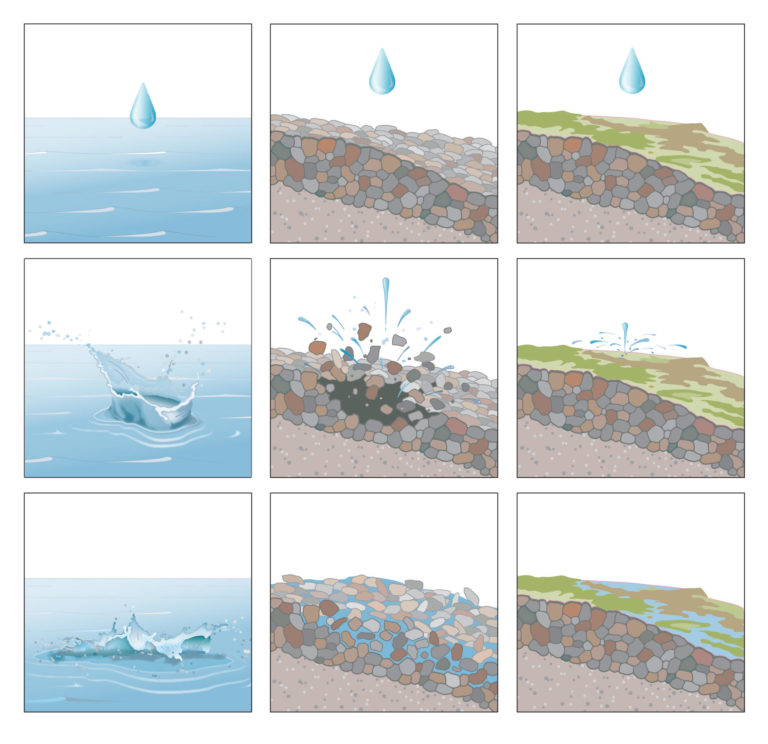In conservation tillage, there is no cultivation of the soil, referred to as no-till, or a minimal amount of cultivation, referred to as reduced tillage. Consequently, all or a portion of the plant residues remain on the soil surface rather than being incorporated into the soil by plowing or disking. The new crop can be planted directly into the plant residue or into small tilled strips, created using strip-tillage. Conservation tillage is typically defined as tillage that leaves a minimum of 30 percent of the soil covered by plant residue.
Cash crop and cover crop residues left on the soil surface protect the soil from the erosive effects of rainfall and wind. When raindrops hit bare soil, the energy is transferred to the point of impact. This can dislodge soil aggregates, compact the soil surface layer and lead to increased erosion and transport of soil. When raindrops hit growing plants or crop residue, the energy is dissipated, reducing erosion and compaction (Figure 14.2).
Along with reducing erosion, conservation tillage systems improve infiltration. Compaction reduces infiltration and, inevitably, restricts water flow to the root zone. The compaction caused by rainfall can be minimized by plant residue on the soil surface. Surface residue also slows runoff, which increases infiltration because water stays on the surface longer. In no-till and reduced-tillage systems, increased organic matter and the presence of macropores consisting of wormholes, cracks and root channels, improve the soil’s structure. Increased organic matter improves the soil’s water-holding capacity, and better soil structure encourages infiltration rather than runoff. Tillage disrupts these transport pathways and reduces both infiltration and water-holding capacity. Keeping the soil covered with plant residue or a closed crop canopy is critical to reduce soil erosion and optimize infiltration.
The benefits of conservation tillage for reducing surface runoff are well documented. In the southeastern Coastal Plain on a loamy sand soil with a 3 percent slope, strip-tillage has been shown to reduce surface runoff by 55 percent compared to conventional tillage [1]. For a region that receives an annual rainfall of 48 inches, this can mean an extra 6 inches of rainwater for crops throughout the year. Another study found a 99 percent decrease in surface runoff from a no-till field on a 9 percent slope compared to a similar field in conventional tillage [2].
The increase in infiltration with reduced tillage varies by soil type [3]. The Natural Resources Conservation Service (NRCS) classifies soils into four hydrologic soil groups designated Groups A, B, C and D. Group A soils are sandy soils and have a high infiltration rate when wet and a high rate of water transmission, which is the rate of water movement through the soil when saturated. Group B soils have a moderate infiltration rate when wet and a moderate rate of transmission. Group C includes soils with a slow rate of infiltration when wet and slow transmission rates. Group C soils have a layer that impedes the downward movement of water or they are moderately fine textured to fine textured. Group D soils have slow infiltration rates when wet and very slow water transmission. Group D soils include clays, soils with a permanent high water table, soils with a claypan near the surface, and soils that are shallow and over nearly impervious material.
A literature review revealed 19 studies on Group B soils and each documented decreases in water runoff with no-till. Runoff averaged 56 percent of that observed from the conventional till sites. Of the 26 studies of Group C soils, 22 (85 percent) documented reductions in runoff with no-till, with runoff averaging 67 percent of that from conventional tillage. Of the 11 studies on Group D soils, only one (9 percent) indicated a runoff reduction with no-till, but there was no difference in the average runoff from the two systems. No studies on Group A soils were found. The review concluded that no-till could be expected to reduce runoff on Group B and Group C soils but not on Group D soils (Table 14.1) [3].
Crop and cover crop residues on the soil surface dissipate raindrop impact, slow surface runoff and often increase infiltration. Residue also serves as a barrier against evaporative water loss from the soil and this increases the amount of water available for crops [14]. Crops that leave a lot of residue on the soil surface generally provide greater benefits. Winter cover crops generate considerable surface residue and keep the soil surface protected. In general, the more residue on the soil surface, the better the results.

